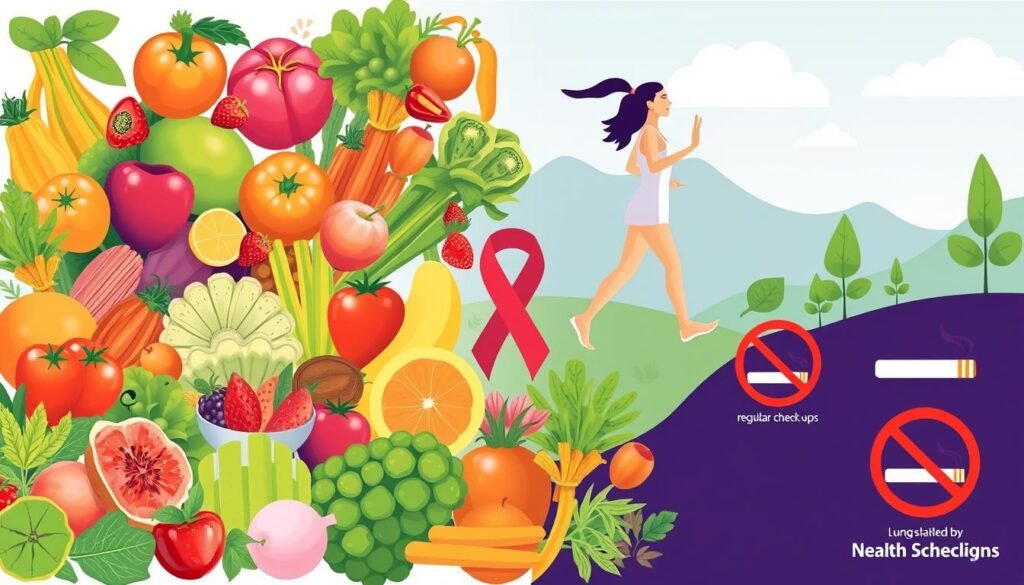Every year, the U.S. faces over 234,000 new lung cancer cases. This makes it a significant health issue worldwide. While smoking and the environment play big roles, genes also matter a lot. About 5-10% of all cancers are linked to family history. This shows how crucial it is to understand genetic risks, especially for those with relatives who’ve had lung cancer. Knowing about lung cancer susceptibility genes can lead to better prevention and treatments for those at highest risk.
Scientists are studying how genetics and environment work together in lung cancer. Genetic tests could help find the genes that increase lung cancer risk. Knowing these can help doctors create better plans to prevent and treat cancer. This could help lower the death rates from this disease.
Key Takeaways
- Lung cancer is responsible for over 234,000 new cases each year in the U.S.
- Genetic predispositions play a significant role in lung cancer risk, regardless of smoking habits.
- Understanding familial patterns of lung cancer can enhance healthcare strategies.
- Genetic testing may aid in identifying specific susceptibility genes.
- Targeted therapies based on genetic profiles can lead to better patient outcomes.
- Environmental factors and genetics together contribute to the complexity of lung cancer development.
Understanding Lung Cancer
Lung cancer is a major health issue that comes in two major types. These are small cell lung cancer (SCLC) and non-small cell lung cancer (NSCLC). It starts from unusual cell growth in the lungs, forming tumors. Often, lung cancer doesn’t show clear signs until it’s pretty advanced. Symptoms like constant coughing or chest pain then appear.
Many things lead to lung cancer, including changes in genes. Research shows that 60% of people with a certain lung cancer have special gene changes. About 10% of certain lung cancer cases have changes in the EGFR gene. Another 25% have changes in the KRAS gene. Even if only 8% of lung cancers are due to genetics, knowing your family history helps.
Things around us can also raise the risk of getting lung cancer. Smoking is a big one, making smokers way more likely to get lung cancer than non-smokers. They’re 15 to 30 times more at risk. Secondhand smoke and radon gas are also big risks, mainly for those who don’t smoke. Being around harmful chemicals like asbestos and diesel fumes can also increase the risk.
It’s even more important now to understand lung cancer well. Many who get diagnosed are older than 65. This shows how vital it is to prevent and screen for this disease early. By knowing the genetic and environmental factors, we can better prevent and treat lung cancer.
Types of Lung Cancer
Lung cancer splits into two key types: small cell lung cancer (SCLC) and non-small cell lung cancer (NSCLC). Knowing the difference is key for diagnosis and deciding on treatment.
Most lung cancer cases, about 85%, are non-small cell lung cancer. NSCLC has three main subtypes:
- Adenocarcinoma: This kind starts in the lung’s outer parts. It’s most common among non-smokers.
- Squamous cell carcinoma: Often seen in smokers, this subtype begins in the central airways.
- Large cell carcinoma: Although rarer, it can develop anywhere in the lung and grows quickly.
Small cell lung cancer makes up around 15% of cases. It’s known for fast growth and spreading early. It’s mostly linked to heavy smoking and responds well to chemotherapy. Yet, its quick spread makes it hard to treat.
Understanding the differences between lung cancer types is crucial. It helps in creating better treatment plans and pushes forward research. This leads to better care and outcomes in lung cancer treatment.
Importance of Risk Factors in Lung Cancer
It’s key to know the lung cancer risk factors for awareness and prevention. Smoking is a major cause, causing almost 90% of these cases. By cutting out smoking, we could prevent nearly 90% of lung cancers.
Genetic risk factors for lung cancer also play a big role. Having family with lung cancer increases your risk too. If two or more close family members are diagnosed, the risk is even higher. In fact, having a first-degree relative with lung cancer raises your own risk by 50%.
There are environmental risks too, aside from genetics. Asbestos exposure leads to 70%-80% of mesothelioma, a lung cancer type. Also, radon in homes is the second top cause of lung cancer. It’s responsible for about 30% of lung cancer deaths in non-smokers.
For lung cancer prevention, we must tackle genetic and environmental factors. Knowing your risk, especially if you have a family history or exposure to harmful substances, is vital. By changing our lifestyles, getting educated, and improving our environments, we can lower our risks.
Genetic Predispositions to Lung Cancer
Genes play a big part in the risk of getting lung cancer. Certain genetic mutations linked to lung cancer are found in genes like TP53 and EGFR. These are key in raising the chances of getting the disease. It’s important to understand how these genes affect lung cancer in families.
Overview of Genetic Contributions
Some mutations can make a person more likely to get lung cancer. If you smoke and have these genetic factors, your risk is even higher. Research on over 12,000 smokers showed changing one’s habits can lower the risk. This shows that genes and actions both play a role.
Familial Patterns of Lung Cancer
Familial lung cancer usually comes from a genetic pattern that runs in families. It means if your family has it, you might be at greater risk. Studies show that relatives of lung cancer patients often face a higher risk. This risk is due to both genes and the environment shared among families. The heritability of lung cancer for current smokers is estimated at 0.41. This number reveals how much genetics can influence cancer risk in families.
| Study Findings | Details |
|---|---|
| Mutation Impact | Increased risk of lung cancer linked to TP53 and EGFR mutations |
| Familial Incidence | Higher rates of lung cancer diagnosed in families with history |
| Genetic Influence | Heritability estimate of lung cancer at 0.41 for current smokers |
| Smoking Cessation Benefits | Quitting smoking can cut lung cancer risk in half for predisposed smokers |
| Causal Relationships | Evidence shows genetic predisposition coupled with smoking enhances risk |
Environmental Risk Factors for Lung Cancer
Environmental risk factors are key in lung cancer development. Smoking is the top cause but not the only one. About 85% of lung cancer cases stem from smoking. Yet, long-term exposure to environmental carcinogens is also a major concern. These harmful substances come from industrial and residential activities and natural sources like radon gas.
- Air pollution from cars and factories
- Second-hand smoke inhalation, posing big risks to children
- Work-related exposure to substances like asbestos and some pesticides
- Radon gas in homes built on uranium-rich soil
Statistics show worrisome trends in pollution-related lung cancer risks. For instance, outdoor air pollution causes around 108,000 lung cancer deaths a year. In less developed countries, cooking and heating with solid fuels lead to about 36,000 deaths annually. These numbers highlight the urgent need for public health actions and policies to lessen environmental carcinogen exposure.
Workplace environments present special risks. Some jobs, especially in pesticide-related fields, have higher lung cancer rates due to carcinogens like chlorophenols and dioxins. It’s crucial to keep monitoring these workplaces to reduce the risks.
As evidence about environmental effects on lung health grows, fighting pollution becomes more important. Tackling these risk factors through education, policy changes, and community efforts is key. This approach can help decrease lung cancer worldwide. This emphasis is backed by recent studies, pointing out ways to prevent lung cancer.
Smoking and Its Impact on Lung Cancer
Smoking is the top reason for lung cancer all around the globe. It deeply affects individuals and public health. Many studies prove a strong connection between smoking and lung cancer. They show up to 90% of lung cancer cases result from smoking. Cigarette smoke contains harmful substances. These substances include carcinogens that increase lung cancer risk.
Primary Smoking Risks
Smoking daily affects your chances of getting lung cancer in many ways. The risk goes up with the number of cigarettes smoked and how long you’ve smoked. If you smoke, you are 15 to 30 times more likely to get lung cancer or die from it compared to non-smokers. Even smoking just a few cigarettes sometimes raises this risk. But quitting smoking can cut down this risk a lot, no matter your age.
Secondhand Smoke Exposure
Secondhand smoke is very risky for people who don’t smoke. It exposes them to lung cancer dangers. Secondhand smoke from cigarettes, pipes, or cigars raises your lung cancer chances. It’s not as strong a cause as direct smoking, but still harmful. Studies show the risk for people in smoking environments. They could breathe in dangerous chemicals without knowing, raising their lung cancer risk.
| Category | Risk Level | Notes |
|---|---|---|
| Smokers | Very High | 90% of lung cancer cases attributed to smoking. |
| Former Smokers | High | Risk remains elevated even after cessation. |
| Secondhand Smoke Exposure | High | Increases lung cancer risk among non-smokers. |

Understanding how smoking and lung cancer are connected shows why quitting is crucial. Boosting awareness can lessen the impact of smoking. This can save lives and lessen the disease’s burden. You can learn more about lung cancer, including its histological characteristics, here.
Occupational Hazards and Lung Cancer
Various industries face significant occupational lung cancer risks due to long-term exposure to hazardous substances. Workers surrounded by toxic materials have a higher chance of getting lung cancer. This is especially true if they’re exposed to cancer-causing chemicals at work. Understanding these risks is key to creating better protective measures and health systems for employees.
Affect of Asbestos and Carcinogenic Chemicals
Asbestos exposure is a top cause of job-related lung cancer. People working in construction, manufacturing, and shipbuilding are especially at risk from asbestos fibers. Breathing in these fibers can lead to lung cancer and other lung diseases.
Other workplace chemicals like silica, diesel exhaust, and polycyclic aromatic hydrocarbons also threaten lung health. Glassmakers and bricklayers, for example, face silica exposure that can raise their lung cancer risk. Meanwhile, diesel exhaust fumes put professional drivers and mechanics at higher risk for lung cancer.
Industries with High Risk
Some jobs have a notably higher chance of lung cancer. Construction work, because of asbestos and silica dust, is one such sector. Additionally, manufacturing jobs that handle chemicals and metals also see more lung cancer cases among workers.
- Construction
- Mining
- Manufacturing
- Textile production
- Automotive repair
These insights highlight the need for strict safety rules and health checks in these dangerous fields. It’s crucial for companies to offer thorough training and safety measures to protect their workers from these risks.
Getting a full picture of these risks is key in lowering lung cancer rates and making workplaces safer. For a closer look at these issues, see this study on occupational exposures.
Role of Air Pollution in Lung Cancer Risk
Air pollution is a big factor in rising lung cancer rates worldwide. It affects both the air outside and inside our homes. By understanding this link, we can work on prevention and better health.
Outdoor Air Quality and Lung Health
Outdoor pollution is closely linked to lung cancer risk. Research shows pollutants, especially fine particles like PM2.5, increase lung cancer risk. Even small increases in PM2.5 are tied to more lung cancer deaths.
This is true for everyone, not just smokers. Air pollution affects us all. In 2017, PM2.5 was linked to 14.1% of lung cancer deaths globally. Long-term exposure to dirty air, especially in cities, raises concerns about our lungs.
Indoor Air Pollution Factors
Indoor air quality is just as critical. Using coal for cooking and heating ups lung cancer risk. This is more common in developing countries. Old heating methods also make indoor air risky.
Being around indoor smoke from cooking or heating is especially bad. Women, particularly in some areas, face more risk due to solid fuel use. Cleaning up indoor air is key to fighting lung cancer and living healthier.

| Source of Air Pollution | Impact on Lung Cancer Risk |
|---|---|
| Outdoor PM2.5 | Significant increase in lung cancer incidence and mortality |
| Indoor coal burning | Strong link to lung cancer, especially in women in developing countries |
| Old heating methods | Contributes to increased indoor air quality risks |
| Ambient air pollutants | Dose-dependent risk of lung cancer in general populations |
Genetic Testing for Lung Cancer Susceptibility
Genetic testing for lung cancer susceptibility is a growing field in oncology. It offers chances for early detection and customized care. This testing seeks to find specific genetic biomarkers for lung cancer. These help doctors know an individual’s risk levels.
People with lung cancer in their family may want to check for inherited lung cancer syndromes. Genetic testing can uncover mutations that raise the risk of lung cancer. This enables proactive monitoring and personalized strategies.
The test process usually looks at tumor tissue to spot gene changes linked to lung cancer. It focuses mainly on non-small cell lung cancer (NSCLC). If a tumor biopsy is not possible, a liquid biopsy using a blood sample is an alternative. Both methods are key in finding changes that can show if targeted therapies might work.
The outcomes from lung cancer genetic testing can greatly impact treatment choices. They can predict how well someone might respond to certain treatments. This helps oncologists pick the best interventions. While results can take days to weeks, understanding what they mean is vital for patients planning their treatment path.
Preventive Measures Against Lung Cancer
Lung cancer prevention is key to fighting this disease. Smokers have a much higher risk, 20 times more than non-smokers. Quitting smoking is crucial. Programs that help people stop smoking can greatly lower the risk.
Teaching the public about the dangers of secondhand smoke is vital. This smoke can increase a non-smoker’s risk by 20%. Healthier choices can come from these teachings, leading to better prevention.
It’s important to look at the air we breathe too. Outdoor pollution can raise lung cancer risk by 40%. Workplaces with carcinogens like asbestos need safer practices. Taking steps to reduce exposure can significantly cut down lung cancer cases.
Diet matters as well, but some supplements like vitamin E don’t help prevent lung cancer. Focusing on a diet full of antioxidants is a better choice.
Stopping smoking, reducing pollution, and education are top ways to lower risk. This is especially true for groups at greater risk, like African American men. Tailored strategies can help them even more.

| Prevention Strategy | Effectiveness |
|---|---|
| Smoking Cessation Programs | Decreases lung cancer incidence |
| Avoiding Secondhand Smoke | Decreases mortality by 20% |
| Reducing Radiation Exposure | Lowers lung cancer incidence |
| Occupational Safety Measures | Reduces risk by over fivefold |
| Public Education Campaigns | Increases awareness and behavior change |
Conclusion
Understanding how genes affect lung cancer is key for better prevention methods. Studies have found that certain genes increase lung cancer risk, especially in smokers. This shows the importance of specific screening and prevention strategies.
By encouraging lifestyle changes and raising awareness, people can protect themselves and others. Advancements in genetic testing and treatment offer hope for those facing lung cancer. Ongoing research will lead to new prevention and treatment methods.
The connection between genetics and the environment shows how complex lung cancer is. Learning more about these factors helps us make smarter choices for lung health. This can improve life for patients and those at risk.